When it comes to dressing well, you might think it's all about personal style, but there are essential rules that can greatly impact how others perceive you. For instance, did you know that always buttoning the middle jacket button while leaving the lower one undone creates a more tailored silhouette? This is just one of the guidelines that can enhance your wardrobe and confidence. Understanding these vital dressing rules can transform your approach to fashion, and the next few principles are just as important. So, what else should you keep in mind to elevate your style?
Jacket Buttoning Etiquette
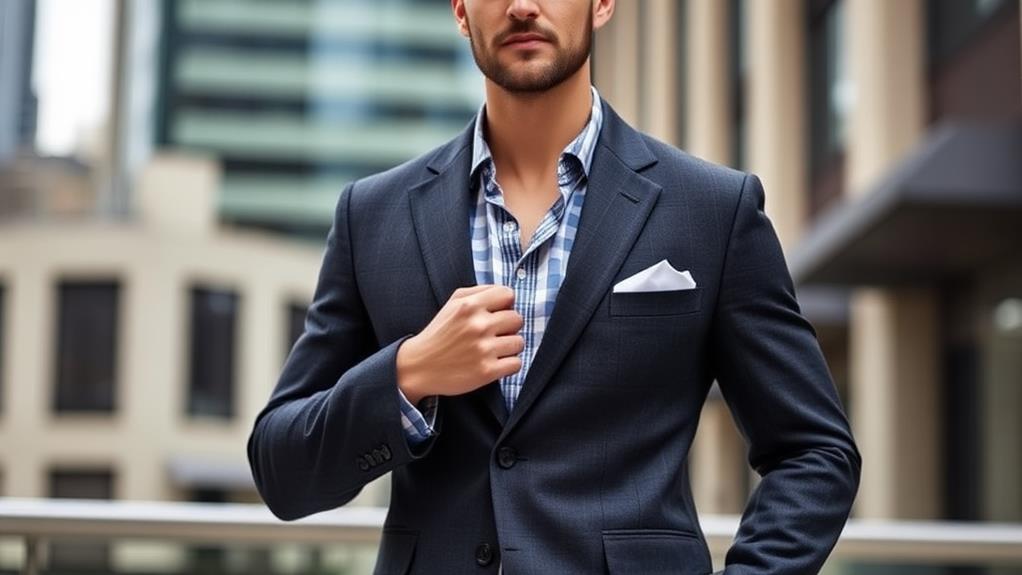
When it comes to style, attention to detail is key, and jacket buttoning etiquette plays an essential role in achieving a polished look. To start, always fasten the middle button on your jacket. This not only keeps your jacket looking sharp, but it also helps maintain its shape. Think of it as the backbone of your outfit!
Now, the upper button is a bit more flexible. You can choose to fasten it based on your mood or personal style, adding a little flair to your appearance. Feel like being daring? Go ahead and button it! Just remember to keep the lower button unfastened. This rule is strict because fastening the lower button can restrict your movement and disrupt the jacket's drape, which isn't ideal for looking your best.
By fastening the middle button, you'll create a snug fit around your waist, making your outfit appear tailored. Leaving the lower button undone allows for graceful draping, ensuring comfort while you move.
Following these jacket buttoning etiquette guidelines not only enhances your overall appearance but also shows that you pay attention to the details in dressing.
Shirt Buttoning Guidelines
When it comes to buttoning your shirt, keeping it modest is key. You should only leave unbuttoned up to two buttons to maintain a polished look, especially in professional settings.
Balancing comfort and style is important, as a well-buttoned shirt shows respect for the occasion and enhances your personal flair.
Modesty in Buttoning
Maintaining modesty while buttoning your shirt is essential for presenting yourself appropriately in any setting. You should aim to keep no more than two buttons unbuttoned on your shirts or blouses. This guideline helps guarantee you maintain an appropriate level of modesty and decorum. When you unbutton more than two buttons, you risk revealing excessive skin, which may not be suitable for various occasions—especially in professional environments.
A well-buttoned shirt not only reflects your personal style but also shows respect for the people around you. By following these modesty guidelines, you create a polished appearance that can leave a positive impression in both social and professional interactions. Remember, it's not just about looking good; it's about feeling confident and self-assured as well.
While you may want to express your individuality through fashion, the key is to balance that desire with modesty. So, next time you get dressed, think carefully about how you button your shirt. Keeping it modest can enhance your overall presence and help you navigate different settings with ease and confidence.
Balancing Comfort and Style
Finding the right balance between comfort and style can be a challenge, especially when it comes to shirt buttoning. You want to feel relaxed, but you also want to look polished. A good rule of thumb is to keep no more than two buttons undone. This way, you maintain a neat appearance while still allowing a bit of airflow.
If you unbutton more than two, you risk revealing too much skin, which isn't ideal for professional or formal occasions.
A well-buttoned shirt reflects a balance between your personal style and the decorum needed in various settings. It can boost your confidence and professionalism, especially during important moments like interviews or business meetings.
Comfort is essential, but modesty also plays a vital role in first impressions.
Dress Code Awareness
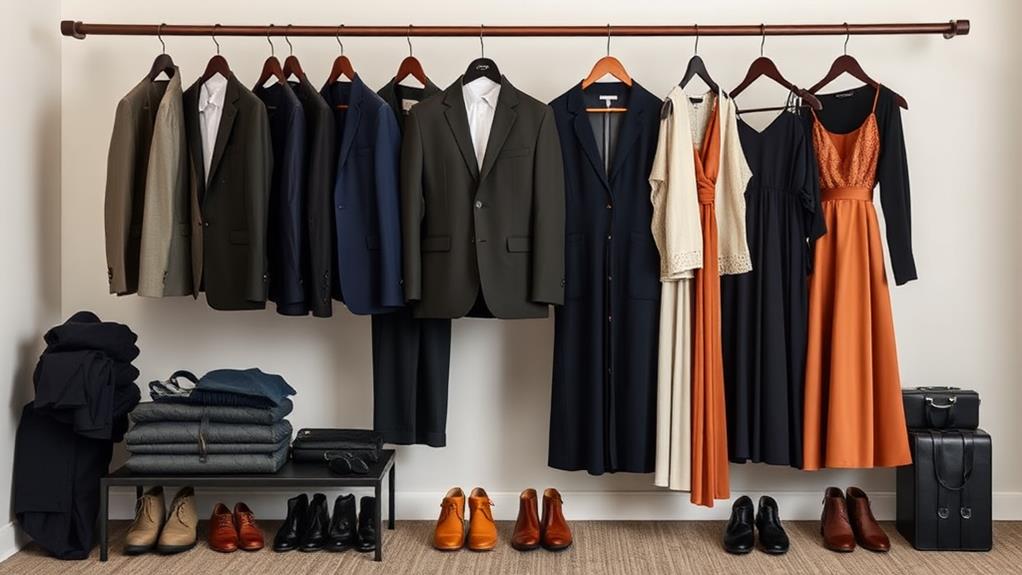
Understanding dress codes is essential for making a positive impression, especially in professional settings like interviews or your first days on the job. Dress code awareness can greatly influence how others perceive you, and it can even impact your career opportunities. It's important to know what's acceptable in various environments.
With the rise of remote and hybrid work, dress codes have evolved. Companies may have traditional guidelines for in-office attire, but you might also encounter more relaxed standards for virtual meetings. To navigate this landscape, researching company culture through their websites and social media can be incredibly helpful. You'll gain insights into what's considered appropriate, helping you align your wardrobe with workplace norms.
Don't hesitate to engage in open discussions with your supervisors about dress code expectations. This can clarify what's suitable and can also allow for personal or cultural considerations in your professional attire.
When you're unsure about what to wear, observe colleagues during interviews or video calls. This practical approach helps you gauge what's considered appropriate while ensuring you maintain a balance between professionalism and comfort.
Accessory Coordination
When it comes to accessories, coordinating them can make a big difference in your outfit's overall look.
Try matching your earrings with your bracelets and making sure your necklaces complement your rings to create a polished appearance.
Match Earrings and Bracelets
Coordinating your earrings and bracelets is a simple yet effective way to create a polished look. When you match these two accessories, you guarantee they complement rather than compete for attention.
Start by considering both color and material; for instance, if you wear silver earrings, matching them with a silver bracelet creates harmony in your outfit.
Aim for a balanced approach by selecting accessories that share a common theme, like matching metals or similar designs. This way, you'll achieve visual symmetry that highlights your overall style.
Plus, wearing matching earrings and bracelets can elevate your outfit, drawing attention to your face and wrists.
However, be cautious not to over-accessorize. Sticking to one or two coordinated pieces helps maintain a polished appearance without clutter.
If you opt for statement earrings, you might pair them with a subtle bracelet for balance. Remember, the goal is to look effortlessly chic, so take a moment to match your accessories thoughtfully.
With a little attention to detail, you can enhance your outfit and showcase your unique sense of style!
Complement Necklaces and Rings
Pairing necklaces and rings can elevate your overall look, making it essential to choose accessories that work in harmony. When you're selecting a necklace, pay attention to the ring's design and color. You want both accessories to complement each other rather than compete for attention.
For instance, if you're wearing a gold ring, opt for a gold or warmer-toned necklace to keep a cohesive aesthetic.
Consider varying the sizes of your accessories to create visual interest. A chunky necklace paired with a delicate ring can add depth and make your outfit more intriguing.
However, be mindful of not overwhelming your look with too many pieces. Wearing more than three or four accessories at once can clutter your appearance and detract from the beauty of your necklaces and rings.
Limit Accessories for Clarity
Limiting the number of accessories you wear is essential for achieving a clear and polished look. When you stack three or four pieces at once, it can create a cluttered appearance that distracts from your outfit instead of enhancing it.
Instead, aim for one or two key accessories that complement each other. Coordinated accessories, like matching earrings and bracelets, create symmetry that draws attention to specific areas of your outfit.
When you choose accessories that accentuate each other, they'll work together rather than compete for attention. This allows your standout pieces to shine, making your overall look more cohesive.
Balancing prints and textures with accessories is also important; they should complement your outfit without overwhelming it.
Coordinating Prints
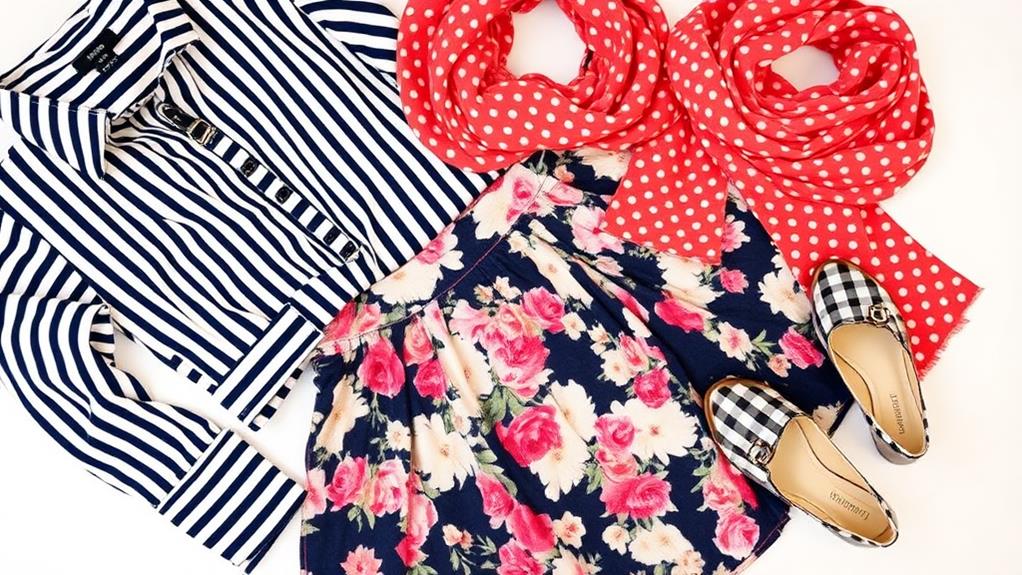
When it comes to mixing prints, finding the right balance is key to creating an eye-catching outfit. Coordinating prints can elevate your style when done thoughtfully. To start, try wearing two prints that share the same color palette. This creates an elegant look, helping the pieces blend seamlessly rather than clash.
Another effective technique is to mix different-sized prints. For example, pair a large floral pattern with a smaller polka dot design. This contrast adds visual interest and harmony to your outfit. Remember, the goal is to enhance your overall aesthetic, not to overwhelm it. Avoid excessive prints, which can make your outfit feel chaotic. Instead, aim for a cohesive look where each piece complements the others, ensuring they work together rather than compete for attention.
Following these guidelines promotes confidence in styling, allowing you to express your personal fashion sense without crossing into disarray. Think of coordinating prints as an art form; a well-rounded and polished look reflects a thoughtful approach to fashion.
As you experiment with prints, don't hesitate to try different combinations. You might discover a unique style that truly represents you! Just remember, balance is essential.
Tie Length and Placement
When it comes to tie length and placement, you want your tie to hit right at your waistline, maybe even a bit lower, for that perfect look.
A well-positioned tie not only completes your outfit but also gives you a polished vibe that's hard to beat.
Plus, matching your tie length with your shirt and jacket creates a cohesive style that shows you mean business.
Ideal Tie Length
Have you ever wondered what the perfect tie length looks like? Achieving that timeless piece in your wardrobe means knowing that the tip of your tie should ideally reach your waistline and cross it slightly. This guarantees proper length and presentation, making you look sharp and professional. A well-placed tie does wonders for your overall appearance, enhancing outfit cohesion and elevating your style.
When you verify your tie length aligns with your shirt and jacket, you create balance in your formal attire. This attention to detail reflects your personal style and professionalism. Remember, a correctly positioned tie doesn't just complete your outfit; it adds a touch of sophistication that can't be overlooked.
Whether you're dressing for a job interview, a wedding, or a special event, mastering the ideal tie length is vital. It shows you care about your appearance and understand the importance of dressing well.
Proper Tie Placement
A properly placed tie is essential for achieving a polished and put-together look. The tip of your tie should reach your waist and ideally cross it slightly. This guarantees proper length, contributing to that neat appearance. Remember, a well-placed tie doesn't just enhance your outfit; it also maintains balance with your shirt and jacket.
One of the important rules that everyone should follow is confirming that the tie length aligns with the proportions of your shirt collar and jacket lapels. This attention to detail creates a cohesive look that speaks volumes about your style.
Choose your knot style and fabric wisely, as these elements reflect your personal style and professionalism.
Regularly checking your tie's placement throughout the day is also key. A quick glance in the mirror can help you avoid any slippage or misalignment, keeping your appearance intentional and sharp.
Style Coordination Tips
Three key elements can make or break your style coordination when it comes to tie length and placement: the fit, the fabric, and the knot. For a polished look, your tie should ideally reach your waist and slightly cross it. This balanced appearance not only enhances your outfit but also reflects your personal style.
When considering style coordination tips, remember that your tie length should align with both your shirt and jacket. If it's too long or too short, it can disrupt the visual balance of your ensemble. A well-placed tie contributes to a cohesive outfit, making you look more put-together and professional.
Don't overlook the details! The knot you choose can also affect how your tie looks. A crisp, well-tied knot will elevate your overall appearance and show your commitment to grooming.
So, whether you're dressing for a formal event or a professional meeting, take a moment to ascertain your tie is just right. Paying attention to these details can truly make a difference in how others perceive your style.
Sock Length Considerations
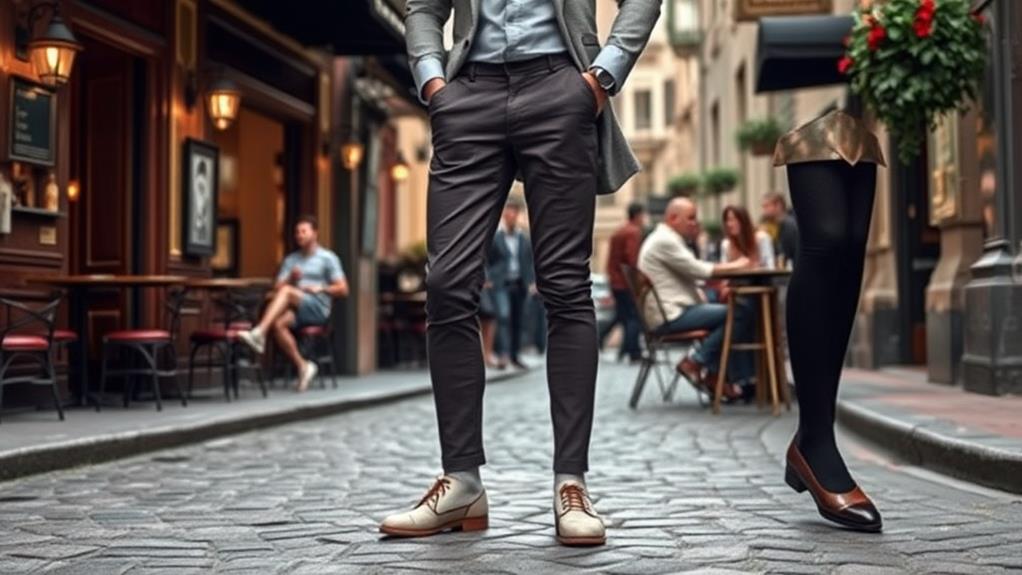
When it comes to sock length, choosing the right option can make all the difference in your overall appearance. Socks come in various lengths, from ankle to knee-high, each serving different style purposes. It's crucial to select a sock length that compliments your outfit and fits the occasion.
For instance, if you're sitting down, your socks should ideally cover your legs completely. This not only maintains a polished look but also prevents any bare skin from showing between your trousers and shoes. You wouldn't want to catch someone's eye for the wrong reasons, right?
Proper sock length also adds to your comfort, especially in colder weather. Longer socks provide extra warmth, making them a practical choice during chilly months. Plus, choosing the right sock length reflects your attention to grooming, enhancing the overall visual flow of your outfit.
In more casual settings, ankle or crew socks can work just fine. However, for formal occasions, opting for longer socks is the way to go. They guarantee a seamless look and help avoid any awkward moments of skin exposure when you move.
Ultimately, it's about feeling confident in what you wear. Paying attention to sock length can elevate your style and show that you care about the details.
Formal Attire Standards
Formal attire standards play an essential role in shaping the impression you make in professional and social settings. When dressing for such occasions, you want to convey professionalism and respect, and adhering to formal attire standards helps you achieve that.
Modesty is key; your clothing should cover your shoulders and avoid revealing styles, like spaghetti straps. If you choose a sleeveless blouse, pairing it with a blazer or cardigan can keep your look polished.
A well-fitted suit is an excellent choice for both men and women. It shows that you take your appearance seriously and understand the importance of first impressions.
Don't forget about your footwear; choose something appropriate that complements your outfit, like dress shoes, rather than casual sneakers. Accessories should be tasteful and not too flashy, as they should enhance your attire, not distract from it.
It's essential to steer clear of overly casual elements like denim or athletic wear. These items can undermine the integrity of formal dress codes and give the wrong impression.
Importance of Removing Tags
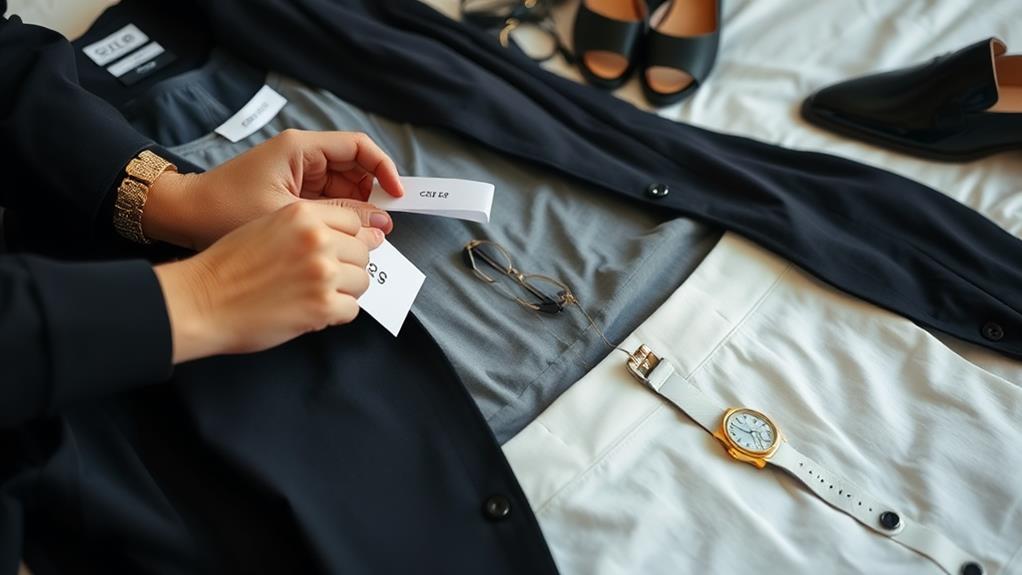
Removing tags from your clothing is a small but significant step toward achieving a polished look. You mightn't realize it, but those visible tags can disrupt the clean lines and overall aesthetics of your outfit. When you take the time to remove tags, you enhance the visual appeal of your garments and contribute to a neat appearance.
Moreover, tags can cause skin irritation or discomfort, especially in close-fitting clothing. This can make your day less enjoyable, as you're constantly aware of that annoying itch. By removing tags, you prioritize your comfort, allowing yourself to focus on your style without distractions.
A polished look is all about eliminating those distracting elements that can detract from your overall presentation. When you walk into a room, you want people to notice your style, not a tag sticking out awkwardly.
Trimming tags is an easy way to present a more professional and put-together image.
Impact of Clothing on Well-Being
Your choice of clothing can dramatically shape how you feel about yourself and how others perceive you. The impact of your outfit goes beyond just style; it plays a significant role in your well-being. For instance, studies show that wearing formal attire can boost your confidence and enhance your ability to think abstractly, especially in professional settings.
When you dress intentionally, it can feel like a ritual that allows you to express your identity and values through your wardrobe. Dressing well isn't just about looking good; it can actually lift your mood and increase feelings of self-worth. Research indicates that when you feel good about your appearance, it positively impacts your overall mental well-being.
Additionally, your fashion choices can reflect your personal aspirations. When you align your outfit with your goals, you might feel more motivated and capable of achieving them. The right attire also enhances social interactions. People tend to respond more positively to those who present themselves well, which can lead to improved relationships and better networking opportunities.
Dressing for Different Occasions
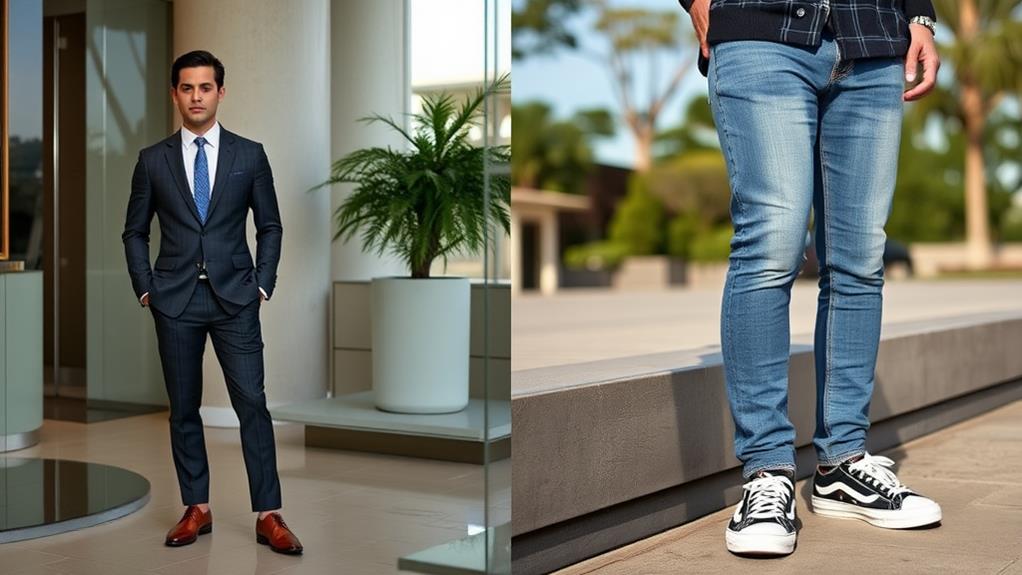
Clothing choices play a significant role in how you present yourself in various settings. When dressing for different occasions, understanding the specific dress code is essential. For instance, if you're gearing up for a job interview or a formal event, aim for business professional attire. This shows respect and professionalism, making a great first impression.
In more casual settings, like a weekend outing with friends, you should still think about your look. Opt for clean, well-fitting clothes while avoiding overly trendy or ripped items. This way, you maintain a polished appearance, even in a relaxed environment.
When it comes to formal events, modesty is key. Choose outfits that cover your shoulders and skip the spaghetti straps to align with traditional expectations of elegance.
For smart casual environments, mix things up! You can balance comfort and style by combining tailored pieces with relaxed items. For example, dark jeans paired with a blazer can create a versatile look that works well in various settings.
Lastly, always be mindful of the cultural context and expectations of the event. If you're unsure about what's appropriate, don't hesitate to ask others about dress norms. This shows your willingness to adapt and helps you make the best choices for dressing for different occasions.

